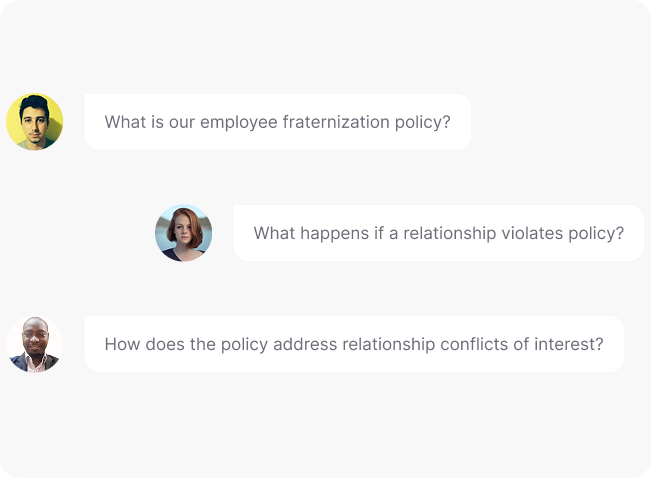Everything You Need to Know About Employee Fraternization Policy
Managing workplace relationships is essential for preserving professionalism and team cohesion. A clear Employee Fraternization Policy sets boundaries to prevent conflicts of interest, ensuring a respectful and unbiased work environment.

What is an Employee Fraternization Policy?
An Employee Fraternization Policy is an HR guideline that defines acceptable boundaries for personal relationships within the workplace. It addresses interactions between colleagues, particularly between supervisors and subordinates, to prevent conflicts of interest, favoritism, and potential breaches of professional conduct.
By clearly outlining the organization’s stance on workplace relationships, this policy mitigates risks related to harassment claims, power imbalances, and workplace gossip, ensuring a professional environment is maintained. A well-structured fraternization policy helps safeguard organizational integrity, promote fair treatment, and minimize disruptions to team dynamics.
Guidelines for Creating an Employee Fraternization Policy
Creating a clear Employee Fraternization Policy ensures professionalism while balancing employee relationships. Here’s what to include:
Define Acceptable and Unacceptable Relationships
Clearly outline what types of relationships are permissible and under what conditions, including guidance on disclosure requirements for romantic relationships that could pose conflicts of interest.
Address Power Dynamics
Highlight the risks associated with relationships involving power imbalances, such as favoritism, bias, or perceived coercion, and specify procedures for managing these situations.
Incorporate Conflict of Interest Provisions
Explain how relationships that may influence professional judgment will be managed, including reassignment of reporting lines if necessary.
Outline Disclosure and Reporting Procedures
Provide a confidential process for employees to disclose relationships that could affect workplace dynamics, ensuring no retaliation for disclosures made in good faith.
Detail Consequences for Non-Compliance
Specify disciplinary actions for violations, including failure to disclose relationships or engaging in conduct that disrupts the workplace.
Ensure Legal Compliance
Align the policy with local and federal labor laws to prevent unintended legal risks, particularly concerning harassment or discrimination.
What is Covered in an Employee Fraternization Policy?
An effective employee fraternization policy should include the following:
Definition of Fraternization
A clear definition of what constitutes fraternization, including personal relationships between employees, especially those with hierarchical power differences.
Scope and Application
Clarification of the policy’s applicability to all employees, across all levels, and how it covers relationships among colleagues, supervisors, and subordinates.
Guidelines for Romantic and Personal Relationships
Guidelines outlining acceptable and unacceptable behavior, particularly regarding workplace relationships that may affect professional objectivity and performance.
Disclosure Requirements
The policy may require employees to disclose certain relationships to HR or management if there’s a potential conflict of interest or a power imbalance.
Consequences for Policy Violations
A clear explanation of the potential consequences for employees found in violation of the fraternization policy, including reassignment, demotion, or termination if necessary.
Encouraging Professionalism
Steps to foster a professional work environment where personal relationships do not interfere with work duties or team dynamics.
Training and Awareness
Employee training to ensure understanding of boundaries and the impact personal relationships can have in a professional setting.
Legal Compliance
A reference to applicable workplace laws regarding workplace conduct, harassment, and discrimination.
Need help creating a employee fraternization policy?
How Winslow Helps HR Teams Streamline Employee Fraternization Policy Management
Managing fraternization concerns requires clear, consistent communication. Winslow’s AI solutions simplify this process for HR teams:

Instant answers anytime
Winslow makes your employee fraternization policy accessible on-demand via Slack, Teams, or email. Employees can quickly understand the organization’s stance on workplace relationships, ensuring compliance and reducing confusion.
Personalized Support
Winslow provides instant answers to all HR questions, including those about your Employee Fraternization Policy, ensuring clarity on workplace relationships and guidelines.


Analytics and Insights
Winslow tracks policy-related queries, helping HR teams identify trends and common concerns. This data enables organizations to refine their policy, improve reporting channels, and address recurring issues proactively.
Streamline Fraternization Policy Management with Winslow
Winslow allows HR teams to manage and address fraternization-related queries efficiently, minimizing misunderstandings and maintaining a professional work environment. HR can respond quickly to concerns and ensure compliance across the organization.
Frequently asked questions
Have further questions about Winslow, contact us at sales@usewinslow.com
Are employees allowed to date each other?
Yes, but employees may be required to disclose romantic relationships, especially if there is a direct reporting relationship, to prevent conflicts of interest.
Can a manager date a subordinate?
Most policies prohibit managers from dating direct reports due to concerns about favoritism, power dynamics, and potential legal risks. In such cases, one of the employees may need to transfer roles or report to a different supervisor.
Are there any restrictions on social media interactions between employees?
While employees are generally free to engage on social media, inappropriate interactions, harassment, or posts that negatively impact the workplace may be subject to disciplinary action.
What happens after an employee discloses a workplace relationship?
HR will review the situation and may take steps to prevent conflicts of interest, such as adjusting reporting structures or transferring an employee to another department.
Are temporary or contract workers subject to the fraternization policy?
Yes, the policy typically applies to all individuals working within the company, including contract and temporary workers, to maintain fairness and professionalism.
What if two employees are married or in a long-term committed relationship?
Married or long-term partners are usually allowed to work together, but they may be restricted from having direct reporting relationships or handling sensitive company decisions together.
What is considered a conflict of interest in workplace relationships?
A conflict of interest arises when personal relationships influence professional decisions, such as promotions, project assignments, or performance evaluations.
Additional resources
Device Usage Policy
Managing employee leave effectively is vital for maintaining workforce productivity and compliance....
Learn moreconfidentiality policy
Protecting sensitive information is crucial. A clear Confidentiality Policy outlines guidelines for...
Learn moreclaim reimbursement
Ensuring fair compensation for expenses is key. A clear Claim Reimbursement Policy...
Learn more




